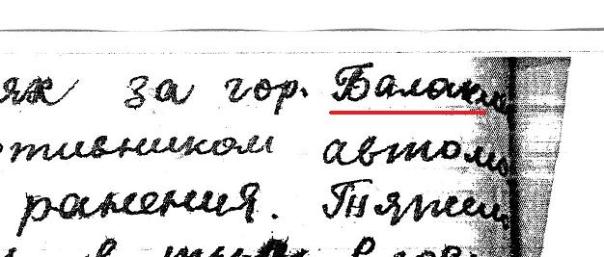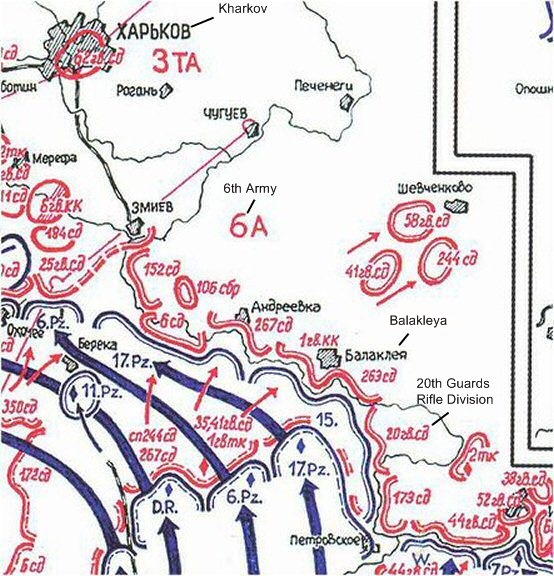Red Army Man Alexey Fedorovich Seliverstov
Good stories, grounded in facts, come from research. By their very nature citation stories usually revolve around a single event, or at most a short series of events. Groups of awards with multiple citations tell the best stories as they follow the exploits of the recipient. Seldom does a single award (with the exception of a long service award), cover actions taking place over a number of years. Imagine my excitement, then, when research on a single Order of Glory returned a citation for actions over the space of almost three years!
On 6 August, 1946, over a year after the surrender of Germany, Red Army Man Seliverstov was awarded the Order of Glory, 3rd class, serial number 604305. No biography, or award card, was returned in the research; the award notice is in “Report Number 364 on awarded orders and medals of the USSR in the Kiev Military District.” The citation had been completed over a year before, signed by Lieutenant-General Kosyakin, second in command of the Kiev Military District, and Major-General Kulakov, member of the military council.
A number of things stand out in the citation. First is his rank, written as “Soldier, riding artillery cart”. Second is his Position and Unit: “Artillery platoon of the 208th detached rifle battalion of the 17th rifle brigade, internal troops of People’s Commissariat of Internal Affairs, Ukrainian Military District.” This is an NKVD unit – the armed forces of the secret police. His service in the GPW is given as from July, 1942 to September, 1945 (when the citation was filled out), and lists not an NKVD billet but “Leningrad Front, the 23rd special rifle brigade,” He was Russian, born in 1923, social status “worker,” and was single. A dependent is listed, an uncle by the name of Nikolay Vasilyevich Seliverstov, living at 15-17 Uzgen passage, Hizmati St, Stalinsky district, Tashkent. But it’s the citation text itself that tells a remarkable story. It begins:
“Red Army Man Seliverstov was drafted to the Red Army in 1942. He served in the frontline of the Great Patriotic War as a rifleman in the 3rd company of the 2nd battalion of the 23rd detached rifle brigade when he was defending Leningrad in the direction of Sinyavino Station. Under an enemy attack, the prospective awardee was firmly holding his defense line and repulsed three enemy attacks, wherein 40 Hitlerites were killed. On September 19, 1942, during the assault on Sinyavino Station, Red Army Man Seliverstov was wounded in the left shoulder blade with a mine fragment and was sent to hospital. After 4.5 months of treatment the prospective awardee returned to the front as ?? to the 3rd battalion of the 20th guards rifle division.”
23rd Rifle Brigade was part of 4th Guards Rifle Corps, which was in the 2nd Shock Army in September,1942. 2nd SA had been the main attack force on the Volkhov Front attempting to relieve Leningrad in the winter and spring of 1942. It was a futile attempt. 2nd SA, including the 23rd RB, had been literally destroyed in fighting from January through June of that year, so Seliverstov must have been a replacement sent that summer. This jibes with information on the initial creation of 2nd SA, given his uncle’s address and the fact he was only 19 when drafted and probably lived with other family members. From The Battle For Leningrad 1941-1944, by David Glantz, p. 154: “As for Sokolov’s new 2nd Shock Army, it had begun formation on late October 1941 in the Volga Military District. Most of its personnel came from the southern and steppe regions of Russia, and its personnel saw forests and marshes for the first time when they were assigned to the Volkhov Front.” .

Monument outside Leningrad in the area where the 23rd Brigade operated, that says, in part “Former strong point… The scene of bloody decisive fighting from 10.09.1941 to 02.10.1943 during the effort to raise the siege of Leningrad from the East”
The 2nd SA was rebuilt in July, and was to take part in a second offensive to relieve the besieged city. That offensive began on 19 August, 1942. It went as badly as its predecessor, and the army was again surrounded and largely destroyed by early October, 1942. Seliverstov’s wound and evacuation in September, barely two weeks before the end, probably saved his life.
His citation reads that he was “Lightly wounded on September 19, 1942”, though four and a half months in recovery argues otherwise. After recovering he was assigned to another unit, though the translator can’t read one word he does identify the unit. The citation continues:
“With the 20th guards division Comrade Seliverstov took part in the battles for the town of Balaklava. In that fight in a hand-to-hand combat with the enemy he received 2 bullet wounds in the chest from a burst of sub-machine gun fire. A heavily wounded Red Army Man Seliverstov was evacuated to a hospital in the rear.”
This is where it gets interesting. This citation is great, but for me it was even better when I read about the action at Balaklava. The siege of Sevastopol is fascinating, and I’ve been interested in an award from that campaign for a long time. Was this OG III, not even created at the time of the siege, such an award? But then I looked closer.
First and most obvious, Seliverstov was wounded on 19 September, 1942, near Leningrad. He then spent 4 ½ months recuperating before being assigned to the 20th GRD. That means that the referenced action at Balaklava could have taken place at the earliest in January, 1943. But the siege of Sevastopol ended at the end of June 1942. Seliverstov couldn’t have been there.
Finding out where the 20th GRD was in early 1943 was the answer. There are a lot of orders of battle (OB) out there for the RKKA in WWII. According to multiple sources it was with the 6th Army, north of the Donets River at that time. 6th Army was part of Southwest Front and rapidly moving west against the shattered German army in January, 1943.
By good fortune there was another source, not an OB but a map. The site The RKKA In WWII is a labor of love, is in English (huzzah!) and has a great set of maps. This map shows the placement of the 20th GRD, and lo and behold it’s placed near the town of Balakleya. (It’s part of this full map at the RKKA In WWII site.)
The similarities are obvious even in the English names. Compare the spellings in Russian:
Балаклава : Balaklava
Балакпея : Balakleya
The translator highlighted Balaklava in the translation just as I have in the above quote, implying that he wasn’t sure if he’d got it right. And I can’t blame him; the citation shows one of the mundane but all too common problems with getting research. The dreaded “photo copy on the bound edge of the document” syndrome. Most of the time one can discern what the word is. But this is a perfect example of when that’s not true.

A portion of the citation. The underlined word is Balakleya, but it’s obvious why the translator misread it.
But while it’s not Balaklava, it is an important battle. The 20th Guards Rifle Division helped fight off the “Backhand Blow,” Manstein’s counteroffensive that routed the Soviet 6th Army and culminated in the third battle of Kharkov. It turned out to be the last major victory for German forces in Russia. Upwards of 50 Soviet divisions were put out of action, and Kharkov retaken. 20th GRD was rushed to the front south of Kharkov to help stop the panzers in March, 1943, and fought against 1st Panzer Army near the town/city of Balakleya. And in that fight Seliverstov was again wounded and evacuated.
The commander of the Soviet 6th Army issued an exhortation to his forces on 1 March, 1943, that gives an precise view of what Seliverstov faced. It reads in part:
“The enemy is continuing to develop his offensive along the Balakleia and Alekseevka axis with tank units and motorized infantry, and his forward units, consisting of small tank groups (3-5 tanks), with small groups of submachine gunners, are brazenly bursting through to the Northern Donets River.” [Order no. 0094 of the commander of the 6th Army]
Seliverstov’s “2 bullet wounds in the chest from a burst of submachine gun fire’ undoubtable came during just such an engagement.
How long he was in hospital is a mystery, but one that can be solved by looking again at his citation. It states that he was in the NKVD unit from November, 1943. That means that he was out of action for eight months. Given two bullets in the chest a rather long recovery makes sense. His citation continues:
“Upon recovery, the prospective awardee was sent to the 208th detached rifle battalion of the 17th rifle brigade, Internal Troops of People’s Commissariat of Internal Affairs, Ukrainian Military District.
Red Army Man Seliverstov, when in service in the 208th detached rifle battalion, proved himself a disciplined and exemplary soldier. He accurately carries out all given orders and always observes the articles of war. Comrade Seliverstov displays bravery and courage in the fight against Ukrainian nationalists, he has killed 4 bandits and captured 11 bandits.
Deserves the government award, order of Glory, 3rd class.”
Seliverstov’s war didn’t end with the fall of Germany. War against UPA, the Ukrainian Insurgent Army continued into the 1950s, and as a soldier with the NKVD it was his lot to continue fighting. His citation mentions “he always observes the articles of war,” though it’s debatable how to interpret this. The fight against the UPA was a terrible guerrilla versus counter insurgency war. Civilians were targeted by both sides, horrible attrocities were perpetrated. Perhaps the comment is sincere, and Seliverstov was an example of honorable behavior in a too often dishonorable war.
Whether he ended the war as he began it, as a common soldier, we can’t know. When he finally got to go home is also unknown. But to me this single medal has more story behind it than many officer’s groups of higher awards of much greater value, even without the biographical information of Red Army Man Seliverstov.


